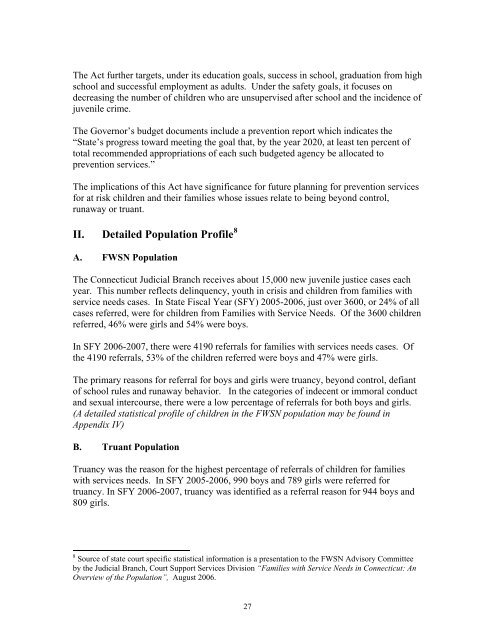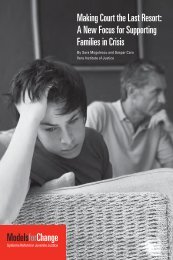FWSN-advisorybd-repo.. - The Connecticut Juvenile Justice Alliance
FWSN-advisorybd-repo.. - The Connecticut Juvenile Justice Alliance
FWSN-advisorybd-repo.. - The Connecticut Juvenile Justice Alliance
You also want an ePaper? Increase the reach of your titles
YUMPU automatically turns print PDFs into web optimized ePapers that Google loves.
<strong>The</strong> Act further targets, under its education goals, success in school, graduation from high<br />
school and successful employment as adults. Under the safety goals, it focuses on<br />
decreasing the number of children who are unsupervised after school and the incidence of<br />
juvenile crime.<br />
<strong>The</strong> Governor’s budget documents include a prevention <strong>repo</strong>rt which indicates the<br />
“State’s progress toward meeting the goal that, by the year 2020, at least ten percent of<br />
total recommended appropriations of each such budgeted agency be allocated to<br />
prevention services.”<br />
<strong>The</strong> implications of this Act have significance for future planning for prevention services<br />
for at risk children and their families whose issues relate to being beyond control,<br />
runaway or truant.<br />
II. Detailed Population Profile 8<br />
A. <strong>FWSN</strong> Population<br />
<strong>The</strong> <strong>Connecticut</strong> Judicial Branch receives about 15,000 new juvenile justice cases each<br />
year. This number reflects delinquency, youth in crisis and children from families with<br />
service needs cases. In State Fiscal Year (SFY) 2005-2006, just over 3600, or 24% of all<br />
cases referred, were for children from Families with Service Needs. Of the 3600 children<br />
referred, 46% were girls and 54% were boys.<br />
In SFY 2006-2007, there were 4190 referrals for families with services needs cases. Of<br />
the 4190 referrals, 53% of the children referred were boys and 47% were girls.<br />
<strong>The</strong> primary reasons for referral for boys and girls were truancy, beyond control, defiant<br />
of school rules and runaway behavior. In the categories of indecent or immoral conduct<br />
and sexual intercourse, there were a low percentage of referrals for both boys and girls.<br />
(A detailed statistical profile of children in the <strong>FWSN</strong> population may be found in<br />
Appendix IV)<br />
B. Truant Population<br />
Truancy was the reason for the highest percentage of referrals of children for families<br />
with services needs. In SFY 2005-2006, 990 boys and 789 girls were referred for<br />
truancy. In SFY 2006-2007, truancy was identified as a referral reason for 944 boys and<br />
809 girls.<br />
8 Source of state court specific statistical information is a presentation to the <strong>FWSN</strong> Advisory Committee<br />
by the Judicial Branch, Court Support Services Division “Families with Service Needs in <strong>Connecticut</strong>: An<br />
Overview of the Population”, August 2006.<br />
27
















